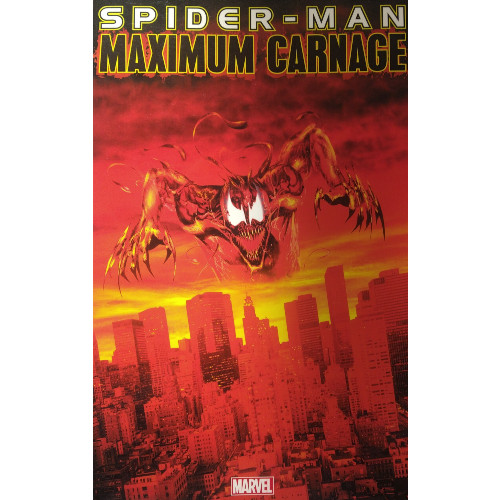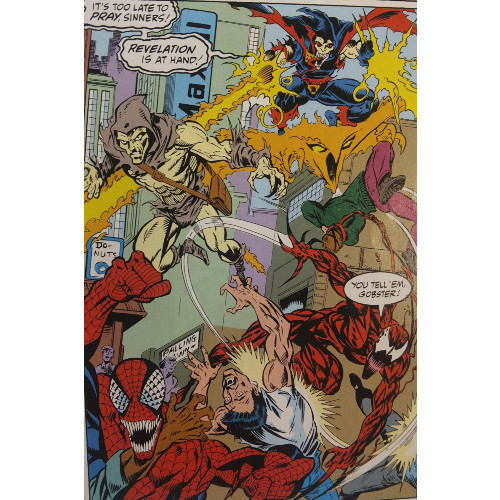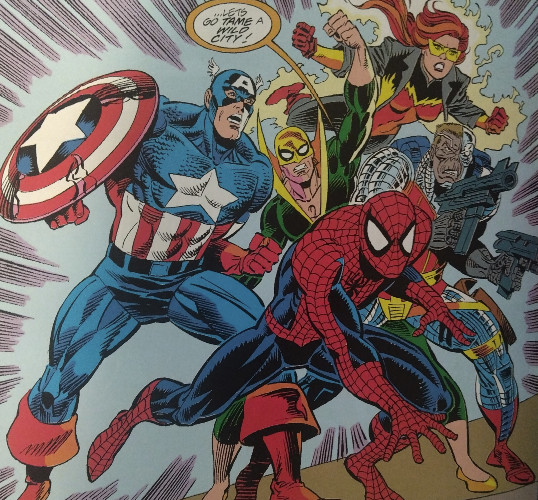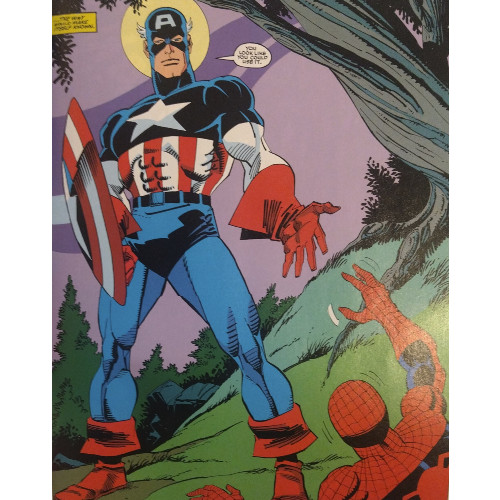Spider-view: "Maximum Carnage" (Venom, Part 10)
This infamous crossover is a mess from start to finish, interesting bits of plot and characterization consumed by overbearingly grim darkness and violence
—by Nathan on July 1, 2025—

This is my third time writing this review.
I have mentioned my ever-shifting writing/posting schedule in other reviews. "Maximum Carnage" has been another victim of that chaos. I fully intended to reach "Maximum Carnage" a lot sooner than I did, originally planning to skip over a whole bunch of smaller issues and stories and nailing some of the bigger, more impactful Spider-Man stories on my trek to the "Clone Saga."
Didn't happen.
I first read "Maximum Carnage" somewhere around four years ago and wrote a scathing review which obliterated the narrative. Wanting to give it a second chance, I read it again about three years ago and wrote a second review which was primarily a response to the first, reevaluating my perspective on the crossover arc. Neither of these reviews will ever see the light of day. It's been quite a while since that rewrite as I have examined many more narratives through "Spider-view" than I initially intended, meaning I felt it only fair to give "Maximum Carnage" a third shot, see if maybe with time, my stance on the story had softened.
We'll see how debatable that idea is.
Okay, context time: Peter has just lost his best friend, Harry Osborn, to side effects from the same formula which endowed Norman Osborn his Goblin strength. The very first chapter of "Maximum Carnage" gives us a funeral scene, where it establishes Peter's grief from not only Harry's passing but the knowledge that being Spider-Man encircles him with death. He pledges to MJ that he will take a break from being Spider-Man for a time…
…which means it's the absolutely worst/perfect time for Carnage to reappear.
"Maximum Carnage"
Writers: David Michelinie, J.M. DeMatteis, Terry Kavanagh, Tom DeFalco
Pencilers: Alex Saviuk, Mark Bagley, Ron Lim, Sal Buscema, Tom Lyle
Inkers: Sal Buscema, Sam de la Rosa, Randy Emberlin, Scott Hanna, Don Hudson, Al Milgrom, and Jim Sanders III
Colorists: Joe Andreani, Jim Houston, John Kalisz, Chris Matthys, Ericka Moran, Bob Sharen, Kevin Tinsley, and Nel Yomtov
Letterers: Steve Dutros, Chris Eliopulous, Rick Parker, and Joe Rosen
Issues: Amazing Spider-Man #378-380, Spectacular Spider-Man #201-203, Spider-Man #35-37, Spider-Man Unlimited #1-2, Web of Spider-Man #101-103
Publication Dates: May 1993-August 1993

In an introduction to the "Maximum Carnage" collected edition I own, writer J.M. DeMatteis claims that, when concocting the crossover, the creative team believed they "had a powerful story that looked the Darkness square in the eyes, and came out on the side of Light." In my original review, I ragged on this concept, believing any such moral foundation was only injected at the last minute and, because of the murky darkness and violence that permeates the story so thoroughly, their basic "good vs. evil" lesson failed to hold up. Who cared if the heroes "came out on the side of Light" if they were so tainted by evil themselves? A rather pyrrhic victory, I believed. The story was too violent, the heroes too morally compromised, the villains too one dimensional that any potential moral center felt like it dissipated between panels of violence and bloodshed.
This argument largely holds up two re-reads later and serves as the basis for my general feelings towards the entire crossover.

"Maximum Carnage" is, in some ways, the perfect test run for the "Clone Saga," another 90s Spidey crossover epic. The "Saga" is far longer and more complex in scope, but similarities exist. Several of the same creators who worked on the "Saga" also contributed to this narrative; ethical and moral dilemmas create inner turmoil for our heroes; and "Maximum Carnage" crosses over four existing Spidey titles while introducing a brand new series, a trick its younger, bigger brother would employ in greater breadth.
For this Carnage-focused crossover, you feel the writers hashed out the basic story–and, by DeMatteis' indication, a basic theme–and then went off to script their individual chapters, largely knowing what each other person was creating but not nailing the finer details or determining how best to tell a fourteen-issue arc in a way which would engage the audience throughout its entirety. I don't think gaping plot holes exist here (the synthesis between different chapters is actually quite admirable), but the story never grows beyond its basic premise, despite DeMatteis' promise to the contrary.

That premise: Carnage, imprisoned since his first defeat at the hands of Spidey and Venom, escapes from prison, teaming up with newly introduced villainess Shriek and a small troop of monstrous villains (Demogoblin, Doppelganger, and Carrion) to spread murder and mayhem across New York City. Spidey, knowing he promised MJ to hang up the suit for a short while, tosses the old red-and-blue back on anyway, finding himself paired with Black Cat, Morbius, Cloak and Dagger, Iron Fist, Deathlok, Firestar, Captain America and even Venom (along with a pretty egregious cameo from newcomer Nightwatch, Marvel's response to Image Comics' uber-popular Spawn) to battle back these marauding monsters to reclaim the city from Carnage and Company's grip of death.
With the benefit of hindsight, I believe "Maximum Carnage" could have worked fairly well as a longer crossover arc. The premise does allow potential for some interesting development between characters–Spidey and Venom find themselves at odds over their approaches to defeating Carnage; Spidey does feel somewhat emotionally torn by breaking his promise to MJ; a subplot surrounding supporting cast members such as MJ, Aunt May, and Richard and Mary Parker gives us a few breaks from the near-constant action. We have discussions on the nature of violence and the nature of compromising one's principles. The seeds are there…they're just planted in shallow soil.

Any time a writer throws in a "darker, more violent Spidey" plot, they run a huge risk, namely, because it will always and forever be a temporary turn away from the character's core. Spidey will be tempted, maybe even throttle a couple of folks, before resuming his morally upright, responsibility-driven personality. The risk, I suppose, is that there isn't a risk, that the possibility feels moot from the start, because no matter how frustrated Spidey becomes in the interim, he will wind up back to his roots by time your narrative ends.
The writers attempt to balance this by creating a philosophical discourse between Venom and Spidey's approaches to fighting their combined adversaries, which works marginally better. Venom's involvement hinges on him existing in this villain-turned-vigilante space (his first limited series ended a month before "Maximum Carnage" began), with his definitions of innocence and justice clashing with Spidey. In this debate–and in Spidey's uncertainty in teaming with his famed adversary–the narrative succeeds a tad more, and by throwing in a few other "gray" vigilantes, including the Black Cat and Morbius, we are allowed opposing voices to challenge and influence Spidey. Those voices are certainly appreciated, creating better tension than Spidey's own internal turmoil.

Returning momentarily to DeMatteis' statement, I feel the creators wanted "Maximum Carnage" to embody a deeper, more significant theme of good overpowering evil after being exposed to deep darkness itself. Spidey's turmoil is intended to make his resolve to embrace responsibility all the more impactful. Cloak, aimless after the seeming death of Dagger, finds a spark of light which may tip the balance of the ongoing battle. Richard Parker, a former Soviet prisoner, dredges up the evils of humanity consistently, presenting a counterpoint to kinder characters such as MJ, Aunt May, and even his own son. We're supposed to believe the "good guys" can escape the clutches of disaster and evil and walk away, if not unscathed, then perhaps stronger than they were before diving in headfirst. But the waters are too shallow to provide any real depth.
Similarly, Carnage and Co. follow a basic philosophy regarding their own mission: where our heroes represent life, our angsty adversaries represent death and decay. They reference heavy metal and rage; Carnage recounts part of his troubled childhood; Demogoblin spouts off about his mission to cleanse the world of sinners. They're all about violence and bloodshed, chaos for the sake of chaos, and their rampage is driven by mindless murder. It's a massacre which starts off frightfully impactful–sheer terror through mass murder–but the scenes of death become stale and numbing after a while. "Let's just kill people" is a halfway decent motivation for a villain or group of villains to start off a story, but it isn't enough to carry fourteen chapters. Scenes begin blending like the blood types of their victims, and any creativity in seeing how many ways Carnage can use his symbiote to butcher hapless New Yorkers is quickly subsumed by the sheer amount of death presented.

Our writers attempt to duplicate the divide existing between how and why our heroes fight their foes by placing a similar schism within our villains. They double down on the idea of Carnage and his crew behaving like the most dysfunctional family you've ever encountered–Carnage as father, Shriek as mom, and Doppelganger, Carrion, and Demogoblin as their children. But Carnage becomes an overbearing "parent" as the tale escalates, representing perhaps the one bit of development he receives. His charged emotions fluctuate across the issues, influencing his "family members" and causing conflict. But other than this and the additional backstory, he remains a static character.
You'll have noticed I have referenced the grand number of characters included in this crossover "epic." The total heroes and villains assembled has always been a point of contention for me, because I honestly don't believe the writers can justify the inclusion of every individual present. Characters like Cloak and Dagger and the Black Cat have history with Spidey–Felicia has a touch of grim history with Venom, too–and feel appropriate for the street-level atmosphere of the narrative; Firestar, too, arguably justifies her inclusion through her power set, as symbiotes are vulnerable to fire. But other heroes feel haphazardly thrown in–Deathlok pops up outta nowhere, as does Danny "Iron Fist" Rand; Nightwatch appears, I assume, as a brazen promotion for his own short-lived series; Captain America is intended to offer a beacon of hope at the story's lowest point, but his sudden appearance feels incredibly convenient. And it's Captain America! If you're looking for a hero to instill hope, you naturally pick the guy.

This complaint also exists with the villains. I will note I don't find the choices the writers make for Carnage's crew all that outlandish–Doppelganger, a leftover from Infinity War who previously fought alongside Demogoblin, draws the demonic Hobgoblin into our villains' sphere of influence, and Carrion is a monster whose touch delivers death. It's a decent grouping of violent, inhuman adversaries, and the writers did well in selecting them for their relevance. Problematically, like with some of our heroes, their inclusions are not generated naturally from the story–each one appears rather suddenly and randomly, with Carnage welcoming them into the family. Even Shriek, who, it's implied, has history with Cloak and Dagger, makes her first-ever appearance in this arc's first chapter, a fully-formed villain with a hinted backstory whose character is explored little beyond her abilities.
One of my more significant complaints with earlier reads was that the narrative failed to justify its length–fourteen issues of brawling and bloodshed was a lot to (pun not intended) soak in, and I believed the entire story could have been paired down significantly. That complaint still stands, with some slight tweaking. I found greater structure in the story this time; as I said, each chapter flows fairly well from one to the next, Michelinie, DeMatteis, and Kavanagh picking up where each last writer left us in a round robin style of storytelling. It's the juicy middle which could have been made more lean. Fights tend to feel cyclical–Team Spidey gets the upper hand, then Team Carnage does temporarily, then Spidey, then Carnage, ad nauseam. The villains strike a blow, and the heroes retaliate. Larger plot developments do occur throughout–Dagger is seemingly killed! Venom is kidnapped!–only to be counteracted by multiple small developments which are upended as soon as they happen. Out of a swirling cacophony of movement comes little progress; out of much chaos comes virtually nothing…

…which feels bizarre for me to write given the story's length. Fourteen issues is plenty of space for decent plot and character development to create a solid narrative audiences can appreciate. And yet, with so much going on, we're left with little to chew on at the end. You get all these battles and bloodshed, Spidey's own struggle, the opinions of his vigilante allies, the machinations of our villains, hints of backstory for a few adversaries, and subplots concerning the regular folk like MJ, Aunt May, and Richard and Mary…there's a lot of material here, woven into all these issues. There are pieces which work, standalone scenes which slow the story down momentarily–Dagger pierces Shriek's insanity to reach at the heart of the character in a well-written scene; Carnage tells of his adolescence to provide a small clue as to why he is who he is; a series of twelve panels drawn artfully by Sal Buscema provide a great sequence where Spidey, Firestar, and Venom each wrestle with the concept of Carnage dying.
But these are bits and pieces, and in a story of this magnitude, it's disappointing walking away acknowledging I appreciate bits and pieces. I don't hate "Maximum Carnage." It didn't induce spite the same way Frank Miller's The Dark Knight Strikes Again or some other infamous Spidey stories ("Sins Past," "One More Day," "One Moment in Time") have. But I do feel strongly about it. "Maximum Carnage" is, subjectively speaking, a bad comic.

One review I read noted that Spidey's eventual triumph is a metaphorical knock by Marvel against the darker narratives of the age and and even the general darkness pervading heroes such as ShadowHawk and Cable. In an era dominated by grimdark heroes (evidenced by allies Venom, Black Cat, Deathlok, and Morbius), Spidey delivers more boy scout vibes, and his friendly neighborhood sensibilities drive back the dark philosophies Carnage espouses. This is an interesting reading of "Maximum Carnage," and I won't deny it's a lens I will hopefully someday see the narrative through…just not today.
Such a reading does align with DeMatteis' comments–I do believe the intention is for the reader to come out the other side of the chaos and note that Spidey's inherent heroism is intact. But that feels like a given. The creators were never going to tarnish Spidey's reputation or bring him to a place where he wouldn't rise above his and others' inner demons. Spidey = good. Carnage = bad. It's simple math. The only hint of moral complexity found here are the arguments put forth by Spidey's allies. No one wants us to root for Carnage…but maybe taking him off the board permanently has its upsides? And, yeah, Spidey gives vent to his shadowy edges, but as I noted, the rage was never going to last.

We're walking through the early 90s here. The same era where Superman died, where Batman's back was broken, where Valiant and Image Comics released their first publications. Marvel had just wrapped up Venom's first limited series and brought him back immediately for this crossover. I still feel we're in the "embracing moral ambiguity and violence" era, and I think it'd be difficult to argue Spidey is a stand-in for a company seemingly pushing against the grays and darkness their other comics reveled in on a monthly basis. But Spidey is a good dude, a hero, and he never remains tainted long. That's why he eventually pushes back, even when the shadows whisper for him to step in a little further. The shadows aren't too much for Spidey…but they might be a little much for me. This story is self-indulgent in every issue, and with only a little light to guide the way through, it often becomes a grim swamp. As I said, bits and pieces stand out, but "bits and pieces" are what Carnage wants to leave his victims in, not what I want to find enjoyable in a fourteen-issue crossover extravaganza.